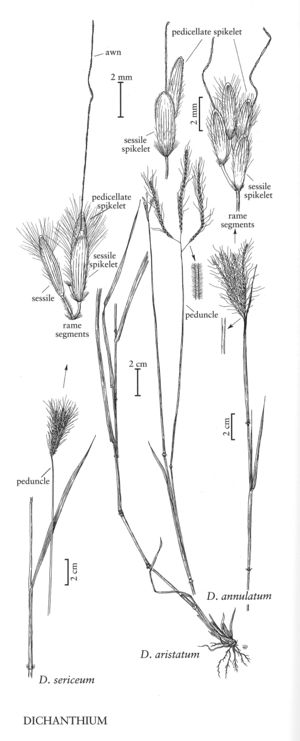Difference between revisions of "Dichanthium annulatum"
FNA>Volume Importer |
FNA>Volume Importer |
||
| Line 20: | Line 20: | ||
-->{{Treatment/Body | -->{{Treatment/Body | ||
|distribution=Puerto Rico;Pacific Islands (Hawaii);Tex.;La. | |distribution=Puerto Rico;Pacific Islands (Hawaii);Tex.;La. | ||
| − | |discussion=<p | + | |discussion=<p>Dichanthium annulatum is native to southeastern Asia and is a highly esteemed forage grass, especially in India. It is now established at scattered locations in Texas, Louisiana, and Florida.</p> |
|tables= | |tables= | ||
|references= | |references= | ||
| Line 36: | Line 36: | ||
|basionyms= | |basionyms= | ||
|family=Poaceae | |family=Poaceae | ||
| + | |illustrator=Linda A. Vorobik and Hana Pazdírková | ||
|distribution=Puerto Rico;Pacific Islands (Hawaii);Tex.;La. | |distribution=Puerto Rico;Pacific Islands (Hawaii);Tex.;La. | ||
|reference=None | |reference=None | ||
| Line 41: | Line 42: | ||
|publication year= | |publication year= | ||
|special status= | |special status= | ||
| − | |source xml=https:// | + | |source xml=https://bibilujan@bitbucket.org/aafc-mbb/fna-data-curation.git/src/314eb390f968962f596ae85f506b4b3db8683b1b/coarse_grained_fna_xml/V25/V25_1547.xml |
|subfamily=Poaceae subfam. Panicoideae | |subfamily=Poaceae subfam. Panicoideae | ||
|tribe=Poaceae tribe Andropogoneae | |tribe=Poaceae tribe Andropogoneae | ||
Revision as of 17:16, 30 October 2019
Plants perennial; stoloniferous. Culms to 100 cm, decumbent, erect portions generally to 60 cm, often branched above the bases, glabrous beneath the inflorescences; nodes glabrous or short-pubescent. Sheaths glabrous; ligules 1-1.8 mm, truncate; blades 3-30 cm long, 2-7 mm wide, scabrous, sparsely pilose, hairs some¬times papillose-based. Rames 2-9, 2.5-7 cm, subdigitate, erect to ascending, bases without spikelets, glabrous, internodes ciliate on the margins. Sessile spikelets 2.5-5 mm long, 1-1.5 mm wide; lower glumes elliptic or oblong, sparsely pubescent below, apices obtuse, irregularly 2-3-toothed, 5-9-veined; upper glumes 3-veined; awns 1.3-2.2 cm, twice-geniculate. Pedicellate spikelets 2.5-5 mm, usually staminate. 2n = 20, 40.
Distribution
Puerto Rico, Pacific Islands (Hawaii), Tex., La.
Discussion
Dichanthium annulatum is native to southeastern Asia and is a highly esteemed forage grass, especially in India. It is now established at scattered locations in Texas, Louisiana, and Florida.
Selected References
None.
